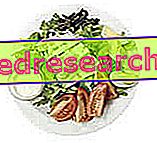Constipation - Causes and Diagnosis
Constipation (or constipation) is a discomfort that affects the mechanism of defecation. It is a symptom and not a true pathology, as constipation is often secondary to:
- anatomical and functional alterations of the intestine (haemorrhoids, fissures, diverticulosis / diverticulitis, rectocele, Crohn's disease, colitis, irritable bowel syndrome, etc.),
- other endocrine or metabolic diseases,
- pregnancy (see constipation in pregnancy)
- incorrect lifestyle and / or unbalanced diet (see diet and constipation),
- disorders / discomforts of the psychological sphere
- pharmacological treatments (see drugs that cause constipation) etc.

The diagnosis for constipation involves the recognition of at least 2 out of 5 of the following factors, for a duration of 12 weeks (even if not consecutive), to be evaluated in the period of about one year:
- less than two weekly evacuations;
- difficulty and effort in evacuation;
- hard consistency of feces or goat feces (segmented) or faeces (thin and flattened);
- feeling of blockage and / or constipation and / or incomplete evacuation
- need for manual help to complete fecal expulsion.
Constipation often accompanies irascibility and asthenia, significantly compromising the quality of life of those suffering from it.
Most of the time, constipation is idiopathic (ie not related to a pathology) and becomes chronic due to: inadequate diet, sedentary lifestyle, pregnancy (uterine dislocation and hormonal profile mutation) and irritable bowel syndrome (disorder not yet well framed). In that case, how to intervene to prevent and treat constipation? Simple, with physical activity and a healthy and correct diet "
Intestinal motility is involuntary (peristalsis), while evacuation is a voluntary act (defecation). In constipation, often, there is an alteration of colic peristalsis and a mutation of the fecal expulsion process.
Treatment
Why does constipation arise? How to cure it?
Peristalsis is a movement that affects the entire digestive tract in a differentiated manner. In the intestine, peristalsis differs in 2 types of contraction:
- segmentation or mixing: promotes the action of intestinal bacterial flora and facilitates the absorption of vitamins, water and salts still present in the faeces
- of progress or mass: it moves the fecal mass up to the rectum, where the evacuation or defecation process is activated.
The mechanism of displacement of the enteric content from the descending colon to the rectum takes place thanks to the alignment between the portion of the sigma and the rectal ampulla, where the feces are contained before expulsion. The evacuation / defecation (which, as anticipated, is a voluntary process) takes place thanks to the perception of the feeling of fullness that triggers the relaxation of the pelvic floor and the anal sphincter; the process can be facilitated by the increase in intra-abdominal pressure generated by the contraction of abdominal muscles and the Valsalva maneuver.

In idiopathic constipation, the problem is often localized "upstream" of the process and generically affects daily habits and lifestyle. In many cases, people with constipation are unaware that insufficient time has been given to this important practice . Moreover, the frenzy of everyday life easily distracts attention from bodily stimuli (not only with regards to defecation, but also as regards thirst, appetite, etc.). On awakening and after meals (for different reasons) defecation should be facilitated compared to the rest of the day; needless to say that just in the morning, after breakfast and lunch, people have less time available than at other times of the day. Correcting these habits, it is therefore desirable that the frequency of evacuations increases, reducing the extent of constipation.
Physical activity prevents and, in some cases, contributes significantly to curing constipation. Not only an active lifestyle, but also desirable physical motor activity have a positive effect on intestinal peristalsis. Sport, you know, is a powerful anti-stress; it goes without saying that these activities can reduce the psychological and emotional distress responsible for the "block" of evacuation. Moreover, from the organic point of view, the vibrations (for example the impact on the ground of the run) and the abdominal muscle contractions intervene on the intestine as a real massage in favor of fecal progression. Not least, the release of cholinergic hormones; these molecules interact with the digestive tract favoring their contraction. It is curious to note that, in parallel, even psychological, emotional and muscular relaxation (although diametrically opposed to motor activity) can prevent constipation; examples of mental training, meditation, etc. are particularly significant examples. The most effective is undoubtedly the yoga that, in association, involves the adoption of diaphragmatic breathing techniques (pranayama) responsible for the visceral massage (on the liver, the spleen and, as an anti-constipation, also on the large intestine) ).
Once established that constipation does not depend on the factors listed above, it is possible to analyze and possibly intervene on food transit mechanisms. The stools progress in the intestine thanks to peristalsis, which is activated following the pressure and the nervous response of the digestive tract. Consequently, the greater the fecal volume, the more frequent and effective contractions are. The stool volume is determined by the quantity of waste / residue / undigested contained in the meals and by the presence of water; moreover, the activation of the intestinal bacterial flora is followed by the production of gases that participate in the increase in intraluminal pressure. The nutritional component that "by definition" contains waste is the dietary fiber. In summary: good amounts of dietary fiber and water in the meal, together with the right concentration of physiological bacteria in the intestine, determine hydration and fermentation (with production of vitamins and other useful molecules, in addition to shielding from harmful agents), then the swelling of the faeces. This condition triggers the peristaltic re-mixing contractions (which further promote the action of the bacterial flora) and, by facilitating the advancement of the mass, speeds up the transit by allowing the rectal ampulla to be filled. The soft consistency of the faeces prevents constipation and the onset of hemorrhoids, fissures (often related to the thrust maneuver in Valsalva) and, indirectly, the probability of the onset of intestinal neoplasms.
Diet for constipation
We carefully analyze the 3 elements that have the best "anti-constipation" function: dietary fiber, water and intestinal bacterial flora.
Dietary fiber against constipation
Dietary fiber is a set of non-digestible molecules for humans, contained in vegetables and mushrooms. They can be classified as soluble and insoluble, or even better in viscous and non-viscous. Both, through different mechanisms, positively intervene against constipation. Those that produce a watery gel (the viscous ones) increase the volume of the feces themselves, while those that, by fermenting, produce gas, increase the intraluminal pressure. While the former do not directly increase the speed of transit but help to preserve the hydration (hence the mass) of the faeces, the non-viscous fibers cause a smooth muscle contraction reaction (segmentation and advancement) accelerating the overall movement. Furthermore, by acting as a substrate for bacterial fermentation, the fiber takes on the role of pre-biotic and improves the production of vitamins and other molecules useful to the body.
The distinction between the two types of fiber is not simple and, to tell the truth, in practice it leaves the time it finds. Vegetables, fruit, algae, cereals, legumes and mushrooms contain (in varying percentages) both types of dietary fiber and in the daily estimate it is first of all necessary to reach 30g TOT (recommended ration also for healthy adult subjects). From here, it is however possible to gradually increase it, while remembering that the fiber (together with other molecules contained by the same foods) also has an ANTI-nutritional function for chelation of mineral salts (especially calcium, iron and selenium).
Water against constipation
Without water, fiber intake may also be in vain (or even counterproductive). Its function of diluting, gelifying and mixing the contents of the stool has a considerable anti-constipation action. The lack of water in the faeces does not allow the increase of the volume and hinders the action of the intestinal bacterial flora compromising the peristalsis. Furthermore, the lack of overall body hydration increases the water absorption of the large intestine increasing the aforementioned effect.
For a diet against constipation it is therefore ESSENTIAL to introduce at least 1 ml of water per kcal taken with the diet, without forgetting that any increase in physical activity promotes the loss of fluids. They are excellent habits to counteract constipation: take water with you and remember to sip it from time to time during the day, drink at least 500-1000ml before, during and after physical activity (depending on your losses) and consume 1 or 2 glasses per meal meal.
Intestinal bacterial flora
it is now clear that the bacterial flora favors nutritional processing, the production of useful molecules and the preservation of the intestinal mucosal integrity. It is genetically determined, but it is also influenced by lifestyle, drugs and nutrition. For some subjects it is very useful to increase their trophism by taking prebiotics (components of dietary fiber) and / or probiotics. The latter are marketed in the form of drugs, supplements and diet foods. As far as food is concerned, it is not certain that they are actually useful in preventing constipation since, undergoing the acid action of gastric juices, most of the live and active bacteria contained in them perish inexorably. On the other hand, an EFFECTIVE treatment of probiotics (to be taken away from meals) by means of drugs or supplements, increases the density of the intestinal bacterial flora with the advantages of which we have already spoken.
lubrication of faeces and intestines
The walls of the digestive tract are involved in physiological mucous secretion; this protective action reduces the friction between the fecal mass and the epithelium, favoring transit and reducing the possibility of abrasion. In the foods are then contained some molecules that possess the same physical characteristic: the lipids. They grease the feces and the walls of the intestine simulating the action of the mucus. Sometimes, enhancing lubrication or preventing it from reducing can be a decisive factor in preventing and treating constipation. Readers will ask, " How can faeces and intestines be lubricated? " Simple, ensuring a total fat intake of between 25 and 30% of total calories.
Avoid Slimming Diets
Recall that some good habits help a lot to fight constipation, such as: eating an abundant breakfast (consisting of solid and liquid foods), avoiding the frenzy of eating meals and taking a comfortable sitting position during breakfast, lunch and dinner.
IMPORTANT! Finally, it should be remembered that certain slimming diets are harmful to the intestine, since they favor the onset of constipation. This reaction is due to several factors:
- Drastic reduction of fiber due to deprivation of cereal derivatives, legumes, fruit and, in the worst case scenario, also of vegetables (which provide food fiber)
- Increased food proteins to the detriment of fats and carbohydrates: fats, as anticipated, act as lubricants and their absence / deficiency causes the increase of mechanical friction in the digestive tract. At the same time, carbohydrates have (like fiber) a marked prebiotic function and a possible depletion compromises the activity of the intestinal bacterial flora; moreover, the protein excess does NOT favor the trophism of the physiological colonies and, often accompanied by ketosis, determines the body dehydration with aggravation of constipation
- Reduction of water contained in food: a large part of the total water is supplied by food; greatly reducing portions and not compensating with that drink, the total water could be insufficient and promote the onset of constipation
Useful foods
There are also foods that lend themselves more than others to the diet for constipation . Among these we highlight: fruits and seeds, leaves, flowers, stems and roots. More in detail, they are excellent against constipation: whole legumes, cereals and whole-grain derivatives, artichokes, cabbage, brussels sprouts, cabbage, apples, pears, carrots, chicory, avocado, carob, chestnuts, feijoa, figs, prickly pears, guava, raspberries, macadamia, dried fruit (but with reduced portions), blueberries, blackberries, olives, passionflower, currants, etc. They excellently perform the anti-constipation function both in raw and cooked form. Cooking promotes food digestibility and promotes partial hydrolysis of some types of fiber, on the other hand, the process should NOT excessively deprive the food from water. The optimal combinations of the above mentioned foods are mixed and cooked, that is to say soups, stews, pastas, caponates etc.
However, despite the very high fiber content, the intake of certain foods is NOT considered positive against constipation. For example, the use of dehydrated fruit (NOT found in water) could have an osmotic effect so strong that it does not improve the disorder and, in some cases, risks worsening it.
Not recommended foods
The CONTRAINDICATED foods for constipation, on the other hand, are all those excessively processed, refined and dry; some examples are dry meat, crackers, breadsticks, taralli, fried snacks, sausages, salted meats, citrus juice (NOT whole citrus fruits), banana etc.
It is finally necessary to specify that, in general, nervine drinks do not directly promote constipation even if, in the case of ethyl alcohol, there is a marked tendency to bodily dehydration, which inexorably affects the aggravation of constipation. On the contrary, in some cases, ethyl alcohol can irritate the intestine to such an extent as to cause diarrhea; this aspect is wrongly interpreted as a relief from those suffering from constipation. On the other hand, it involves a rebound effect that occurs only a few hours after the episode.
Useful supplements
With regard to products capable of moderating constipation, we specify now that no distinction will be made between drugs and supplements; for more information on this, read the dedicated article: Cure for constipation.
The products considered curative for constipation, as they facilitate defecation, are many and belong to different categories.
WARNING! Prolonged use of some laxatives can determine body adaptation and reduce the effectiveness of the product itself; moreover, some laxatives act through chemical-physical mechanisms that are not entirely "healthy" for the intestinal mucosa and its use is recommended ONLY in the case of strict necessity.
- Fibers and lactulose: nutritional components that act by increasing the intraluminal volume and pressure; they can determine the excessive onset of gas
- Osmotic: increase fecal volume by absorbing water from the surrounding environment (sometimes even from the intestine itself); can cause dehydration and abdominal cramps
- Contact: block intestinal water absorption and may cause dehydration
- Emollients: lubricants faeces and intestines; can cause oily losses from the anus.
See an Example Diet against Constipation »



